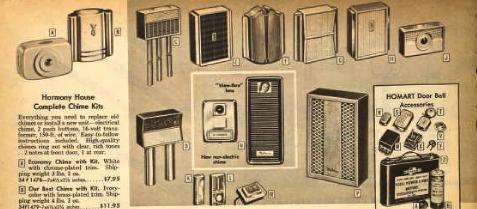New Materials and a New Brand of Doorbells at Sears
After enduring a lengthy depression and the austerity of a total war effort, 1950s America was looking for something new, and Sears was there to oblige. A new wonder material—styrene plastic—made possible many new styles of consumer goods, including doorbells(see sidebar).
From 1952 onward, the Sears catalog featured an ever increasing number of plastic chime covers. By 1955, the majority of Sears Door Chimes featured covers at least partially made of styrene plastic. Many of these chimes featured a more angular look than the gracefully curved streamlined styles of previous years.
This mid-century style brought forth the minimalist aesthetic, as evidenced by newly introduced “recessed chimes”. Like appliances, doorbells with smaller footprints and less ornamentation had appeal for modern homes where there was a movement to hide function.
Sears Harmony House Door Chimes: 1959-1962
In 1959, Sears marketed two door chime kits, complete with a transformer and button, under the Sears “Harmony House” brand.
These kits featured un-badged Nutone Leader and Nutone Commander chimes. These were sold side-by-side with Nutone branded doorbells until the Fall of 1961, when the Nutone brand entirely disappeared from the pages of the Big-Book.
Harmony House door chimes were manufactured by Nutone’s competitor, Rittenhouse. Like Sears’ earlier effort with the Silvertone house brand, the Harmony House Brand for door chimes was quickly abandoned. By the Fall of 1962, Sears doorbells and door chimes were unbranded. In 1963, unbranded chimes shared a page with a newly introduced transistorized 4-way home sound system from Rittenhouse which combined an intercom, AM radio, Fire Alarm and a mechanical Door Chime.

